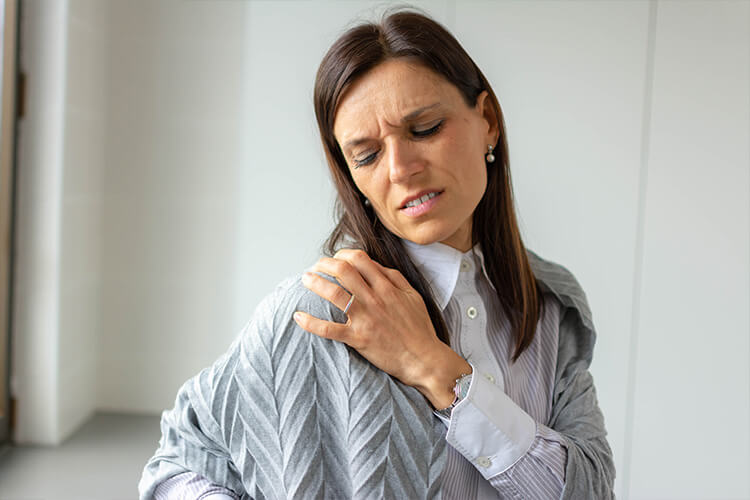Join Our eNewsletter!
Subscribe to our monthly newsletter to receive encouraging advice to help you lead a healthy lifestyle.

Heart Attacks in Women: Know the Signs and Symptoms
By Maygen del Castillo, MD
Heart disease continues to be the leading cause of death for women in the United States, responsible for 1 in 5 female deaths. Despite this staggering statistic, many women are unaware of the signs and symptoms of a heart attack, which can differ from those men experience.
While women will likely feel some type of chest pain, which is the most common symptom for both men and women, it may not be as severe or noticeable as they might expect. Most often, women who’ve had a heart attack describe their chest pain as intermittent pressure and tightness that lasts a few minutes. It’s also possible to have a heart attack and never experience chest pain at all.
Women, more often than men, may have symptoms unrelated to or in addition to chest pain, including:
- Shortness of breath, even when resting
- Lightheadedness or dizziness
- Indigestion or heartburn
- Neck, jaw, shoulder, upper back, or abdominal discomfort
- Pain in one or both arms
- Nausea or vomiting
- Unusual fatigue
- Sweating (when not in a hot environment)
These symptoms may be subtle, possibly due to women having blockages to smaller arteries that supply blood to the heart, as opposed to just the main arteries.

It’s important to note, however, that even if the symptoms are mild, medical assistance should be sought immediately. Women, in particular, tend to ignore signs of a heart attack because they assume it’s something less serious, such as acid reflux or stress and anxiety. But not getting help right away could literally mean the difference between life and death.
Risk Factors for Women
While heart disease is extremely common, it is preventable by reducing your risk factors, some of which differ from risk factors in men. Some of the risks that are common to men and women include having diabetes, being overweight, eating an unhealthy diet, drinking too much alcohol, and not getting enough physical activity. But there are others that are more common in or unique to women.
- Mental stress and depression tend to affect the health of a woman’s heart more than a man’s.
- Smoking is a risky behavior for many reasons, but it appears to be a greater risk factor for heart disease in women than it is in men.
- Menopause can increase risk of heart disease due to low levels of estrogen.
- High blood pressure or diabetes during pregnancy can increase a woman’s long-term risk of these conditions, which in turn increase the likelihood of heart disease.
Take Prevention to Heart
Preventing a heart attack begins with making healthy lifestyle changes. Women of all ages should be aware of their heart health and avoid heart disease risk factors, but those who have a family history of heart disease should pay particularly close attention to their cardiovascular health.
To lower your risk of heart attack:
- Get an annual physical. By staying on top of your health, you and your doctor will be better able to assess your risk of heart disease. Know your blood pressure numbers, have your cholesterol and triglycerides assessed on a regular basis, and get tested for conditions that can contribute to heart disease, such as diabetes. If your doctor prescribes medications for any conditions diagnosed, be sure to take them as directed.
- Don’t smoke. Smoking increases the risk of heart disease due to the chemicals in smoke that cause damage to the blood vessels, arteries, and blood itself. If you smoke, work with your doctor to quit. Ceasing smoking for one year can decrease your risk of heart disease by half. Even if you’ve never smoked, avoid secondhand smoke, which can also damage blood vessels.
- Achieve or maintain a healthy weight. Being overweight can increase your blood pressure and your risk of diabetes, which can both contribute to heart disease. Even losing a few pounds can lower your chances of experiencing a heart attack.
- Exercise. Being more physically active has numerous benefits for your heart, including weight loss, stress relief, better blood circulation, and increased cardiovascular strength. By simply taking a brisk walk 30 minutes a day, you can decrease your risk of a heart attack.
- Eat a heart-healthy diet. By changing your diet to whole grains, fruits and vegetables, low-fat or fat-free dairy, and lean meats, you can lose weight, lower your blood pressure, and decrease your risk of heart disease. You should also avoid saturated and trans fats, added sugars, and high amounts of salt.
- Limit alcohol intake. Long-term alcohol abuse can weaken and thin heart muscle. If you consume more than one drink a day, cut back. One drink equates to 12 ounces of beer, 5 ounces of wine, or 1.5 ounces of liquor. When you do drink, opting for red wine is thought to be the best choice because it contains antioxidants.
Making these lifestyle changes can improve your overall health while decreasing your risk of heart disease and heart attack. Start by making an appointment with your doctor for a physical and bloodwork and to get their guidance on how to take better care of your cardiovascular health.


